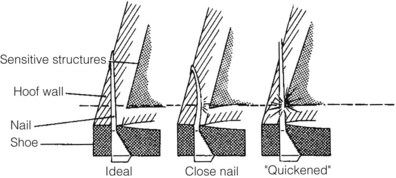Chapter 28 Trauma to the Sole and Wall
Problems Associated with Horseshoe Nails
Nail Bind
History and Clinical Signs
A close nail or nail bind refers to placement of a horseshoe nail not necessarily in the sensitive structures of the hoof, but close enough that the nail exerts sufficient pressure on these structures to cause discomfort. A horseshoe nail is designed to be driven obliquely through the hoof wall. When the nail is driven, the tip is placed at the inner edge of the white line with the bevel of the nail tip facing inward. When driven, the bevel contacts the hard hoof wall and curves outward and exits 1 to 2 cm above the level of the shoe. The tip of the nail is removed and the remainder is bent over to form a clinch to hold the shoe firmly to the hoof. Correct nail placement is important because if the nail is placed too shallow (superficial), the hoof wall will weaken and possibly split; if is it placed in too far, the sensitive structures of the hoof may be entered (pricked) (Figure 28-1). Overzealous clinching of the nails causes inward bending of the nail that can result in pressure on sensitive tissues, which may result in immediate or delayed pain and lameness. Slight displacement of a shoe also can result in nail pressure on sensitive tissues.
Nail Prick
History and Clinical Signs
Nail prick or quicking refers to penetration of the sensitive hoof structures, usually the sensitive laminae, by a driven horseshoe nail (see Figure 28-1). The horse usually reacts as the farrier drives or clinches the nail by jerking the foot from the farrier.1 Sometimes blood appears on the nail or leaks from the nail hole. Nail pricks occur for many reasons and are not always caused by a misdirected nail. Poorly made shoes, misdirected nails, selection of a nail that is too large, poorly placed nail holes, and faulty nails can result in a nail prick. Horses with poor hoof quality, thin hoof walls, or flaring hoof walls can be very difficult to nail and thus are at greatest risk. Fractious horses and young horses that have not been previously shod may lean on the farrier or repeatedly pull the foot from the farrier, making driving a nail difficult. A rushed farrier predisposes to nail pricking, but it can also happen to the best of farriers. Damage from an improperly driven nail can vary from minimal to serious infection.
Thrush
Thrush is a bacterial infection characterized by an accumulation of black, malodorous, necrotic material, usually originating within the central or collateral sulci of the frog of the hoof. This degenerative condition may spread to involve deeper structures of the foot, such as the digital cushion, hoof wall, and heel bulb region, causing inflammation and breakdown of these structures.6 Many keratolytic organisms may be present, but Fusobacterium necrophorum is often isolated. Thrush is most often caused by poor environmental conditions; horses standing in soiled stalls, deep mud, swampy land, or wet pastures are at risk, especially if the feet are not cleaned daily.7 Poor hoof conformation also predisposes to thrush. Saddlebreds, Tennessee Walkers and other gaited horses, and some Warmblood breeds have long feet with naturally deep frog sulci and are at risk of thrush.7 Horses with a sheared heel or acquired frog deformity also are predisposed. Horses shod with full pads may develop thrush secondary to moisture and dirt collection under the pad. Other well-kept, clean horses can develop thrush for no apparent reason. Horses with severe thrush need to be differentiated from those with canker (see Chapter 125 and page 319). Lameness in horses with mild thrush is often blamed on the presence of thrush, but a careful lameness examination will reveal a primary source of pain elsewhere, coexistent with mild thrush.
Sheared Heel
History and Clinical Signs
Sheared heel refers to instability between the medial and lateral bulbs of the heel. Mediolateral foot imbalance may be a predisposing cause. It is frequently but not invariably associated with distortion of the hoof capsule. The medial bulb of heel often is displaced proximally, with a steep medial wall and flaring of the lateral wall (see Figure 6-3). However, instability between the bulbs of the heel can also occur in a more normally conformed foot, and distortion of the hoof capsule as previously described is not synonymous with sheared heel. It is also important to recognize that sheared heel can be present without causing lameness, although sheared heel may be a cause of lameness.




